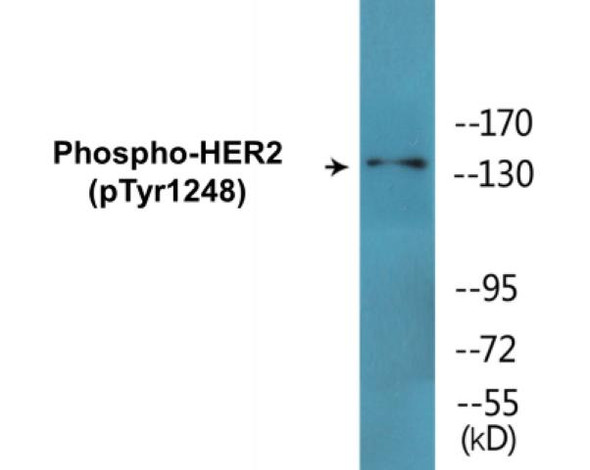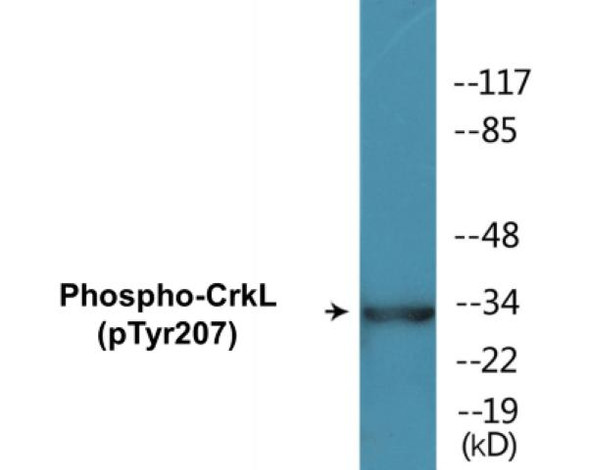Fyn (Phospho-Tyr530) Fluorometric Cell-Based ELISA Kit
- SKU:
- FBCAB00022
- Product Type:
- ELISA Kit
- ELISA Type:
- Cell Based Phospho Specific
- Reactivity:
- Human
- Mouse
- Detection Method:
- Fluorometric
Description
Fyn (Phospho-Tyr530) Cell-Based ELISA Kit
The Fyn (Phospho-Tyr530) Cell-Based ELISA Kit is a convenient, lysate- free, high throughput and sensitive assay kit that can monitor Fyn phosphorylation and expression profile in cells. The kit can be used for measuring the relative amounts of phosphorylated Fyn in cultured cells as well as screening for the effects that various treatments, inhibitors (ie. siRNA or chemicals), or activators have on Fyn phosphorylation.
How does our Fyn (Phospho-Tyr530) Fluorometric Cell-Based ELISA Kit work?
Qualitative determination of Fyn (Phospho-Tyr530) concentration is achieved by an indirect ELISA format. In essence, Fyn (Phospho-Tyr530) is captured by Fyn (Phospho-Tyr530)-specific primary (1°) antibodies while Dye 1-conjugated and Dye 2-conjugated secondary (2°) antibodies bind the Fc region of the 1° antibody. Through this binding, the dye conjugated to the 2° antibody can emit light at a certain wavelength given proper excitation, hence allowing for a fluorometric detection method. Due to the qualitative nature of the Cell-Based ELISA, multiple normalization methods are needed:
| 1. | A monoclonal antibody specific for human GAPDH is included to serve as an internal positive control in normalizing the target RFU values. |
| 2. | An antibody against the nonphosphorylated counterpart of Fyn (Phospho-Tyr530) is also provided for normalization purposes. The RFU values obtained for non-phosphorylated Fyn can be used to normalize the RFU value for phosphorylated Fyn. |
Fyn (Phospho-Tyr530) Fluorometric Cell-Based ELISA Kit -Information
| Product Name: | Fyn (Phospho-Tyr530) Fluorometric Cell-Based ELISA Kit |
| Product Code/SKU: | FBCAB00022 |
| Description: | The Fyn (Phospho-Tyr530) Fluorometric Cell-Based Phospho ELISA Kit is a convenient, lysate-free, high throughput and sensitive assay kit that can monitor Fyn (Phospho-Tyr530) protein phosphorylation and expression profile in cells. The kit can be used for measuring the relative amounts of phosphorylated Fyn (Phospho-Tyr530) in cultured cells as well as screening for the effects that various treatments, inhibitors (ie. siRNA or chemicals, or activators have on FYN phosphorylation. |
| Dynamic Range: | > 5000 Cells |
| Detection Method: | Fluorometric |
| Storage/Stability: | 4°C/6 Months |
| Reactivity: | Human, Mouse, Rat |
| Assay Type: | Cell-Based ELISA |
| Database Links: | Gene ID: 2534, UniProt ID: P06241, OMIM #: 137025, Unigene #: Hs.390567 |
| Format: | Two 96-Well Plates |
| NCBI Gene Symbol: | FYN |
| Sub Type: | Phospho |
| Target Name: | Phospho-Fyn (Tyr530) |
Kit Principle
Figure: Schematic representation of Assay Genie Cell-Based Fluorometric ELISA principle
Kit components | Quantity |
| 96-Well Black Cell CultureClear-Bottom Microplate | 2 plates |
| 10X TBS | 24 ml |
| Quenching Buffer | 24 ml |
| Blocking Buffer | 50 ml |
| 15X Wash Buffer | 50 ml |
| Primary Antibody Diluent | 12 ml |
| 100x Anti-Phospho Target Antibody | 60 µl |
| 100x Anti-Target Antibody | 60 µl |
| Anti-GAPDH Antibody | 110 µl |
| Dye-1 Conjugated Anti-Rabbit IgG Antibody | 6 ml |
| Dye-2 Conjugated Anti-Mouse IgG Antibody | 6 ml |
| Adhesive Plate Seals | 2 seals |
Additional equipment and materials required
The following materials and/or equipment are NOT provided in this kit but are necessary to successfully conduct the experiment:
- Fluorescent plate reader with two channels at Ex/Em: 651/667 and 495/521
- Micropipettes capable of measuring volumes from 1 µl to 1 ml
- Deionized or sterile water (ddH2O)
- 37% formaldehyde (Sigma Cat# F-8775) or formaldehyde from other sources
- Squirt bottle, manifold dispenser, multichannel pipette reservoir or automated microplate washer
- Graph paper or computer software capable of generating or displaying logarithmic functions
- Absorbent papers or vacuum aspirator
- Test tubes or microfuge tubes capable of storing ≥1 ml
- Poly-L-Lysine (Sigma Cat# P4832 for suspension cells)
- Orbital shaker (optional)
Kit Protocol
This is a summarized version of the kit protocol. Please view the technical manual of this kit for information on sample preparation, reagent preparation and plate lay out.
| 1. | Seed 200 µl of desired cell concentration in culture medium into each well of the 96-well plates. For suspension cells and loosely attached cells, coat the plates with 100 µl of 10 µg/ml Poly-L-Lysine (not included) to each well of a 96-well plate for 30 minutes at 37°C prior to adding cells. |
| 2. | Incubate the cells for overnight at 37°C, 5% CO2. |
| 3. | Treat the cells as desired. |
| 4. | Remove the cell culture medium and rinse with 200 µl of 1x TBS, twice. |
| 5. | Fix the cells by incubating with 100 µl of Fixing Solution for 20 minutes at room temperature. The 4% formaldehyde is used for adherent cells and 8% formaldehyde is used for suspension cells and loosely attached cells. |
| 6. | Remove the Fixing Solution and wash the plate 3 times with 200 µl 1x Wash Buffer for 3 minutes. The plate can be stored at 4°C for a week. |
| 7. | Add 100 µl of Quenching Buffer and incubate for 20 minutes at room temperature. |
| 8. | Wash the plate 3 times with 1x Wash Buffer for 3 minutes each time. |
| 9. | Dispense 200 µl of Blocking Buffer and incubate for 1 hour at room temperature. |
| 10. | Wash 3 times with 200 µl of 1x Wash Buffer for 3 minutes each time. |
| 11. | Add 50 µl of Primary Antibody Mixture P to corresponding wells for Fyn (Phospho-Tyr530) detection. Add 50 µl of Primary Antibody Mixture NP to the corresponding wells for total Fyn detection. Cover the plate with parafilm and incubate for 16 hours (overnight) at 4°C. If the target expression is known to be high, incubate for 2 hours at room temperature. |
| 12. | Wash 3 times with 200 µl of 1x Wash Buffer for 3 minutes each time. |
| 13. | Add 50 ul of Secondary Antibody Mixture to corresponding wells and incubate for 1.5 hours at room temperature in the dark. |
| 14. | Wash 3 times with 200 µl of 1x Wash Buffer for 3 minutes each time. |
| 15. | Read the plate(s) at Ex/Em: 651/667 (Dye 1) and 495/521 (Dye 2). Shield plates from direct light exposure. |
| 16. | Wash 3 times with 200 µl of 1x Wash Buffer for 5 minutes each time. |
Fyn (Phospho-Tyr530) - Protein Information
| UniProt Protein Function: | Fyn: a tyrosine kinase of the Src family. Implicated in the control of cell growth. Plays a role in the regulation of intracellular calcium levels. Required in brain development and mature brain function with important roles in the regulation of axon growth, axon guidance, and neurite extension. Blocks axon outgrowth and attraction induced by NTN1 by phosphorylating its receptor DDC. Associates with the p85 subunit of phosphatidylinositol 3-kinase and interacts with the fyn-binding protein. Three alternatively spliced isoforms have been described. Isoform 2 shows a greater ability to mobilize cytoplasmic calcium than isoform 1. Induced expression aids in cellular transformation and xenograft metastasis. In squamous cell carcinoma, Fyn transduces signals from EGFR and Src and is required for cell migration and invasiveness. Activity linked to migration in a murine melanoma model. Appears to block late stage development of neuroblastoma. Mouse knockout deficient in kindling response, a model for human epilepsy. |
| UniProt Protein Details: | Protein type:Kinase, protein; Protein kinase, TK; Oncoprotein; EC 2.7.10.2; Protein kinase, tyrosine (non-receptor); TK group; Src family Chromosomal Location of Human Ortholog: 6q21 Cellular Component: cytosol; endosome; extrinsic to internal side of plasma membrane; lipid raft; plasma membrane Molecular Function:ephrin receptor binding; glycoprotein binding; non-membrane spanning protein tyrosine kinase activity; phosphatidylinositol-4,5-bisphosphate 3-kinase activity; protein binding; protein-tyrosine kinase activity; Ras guanyl-nucleotide exchange factor activity Biological Process: axon guidance; blood coagulation; cell differentiation; cell migration; central nervous system development; ephrin receptor signaling pathway; feeding behavior; innate immune response; learning; leukocyte migration; MAPKKK cascade; peptidyl-tyrosine phosphorylation; phosphoinositide-mediated signaling; platelet activation; regulation of apoptosis; regulation of cell proliferation; regulation of defense response to virus by virus; regulation of phosphoinositide 3-kinase cascade; stimulatory C-type lectin receptor signaling pathway; T cell activation; T cell costimulation; T cell receptor signaling pathway; transmembrane receptor protein tyrosine kinase signaling pathway; vascular endothelial growth factor receptor signaling pathway |
| NCBI Summary: | This gene is a member of the protein-tyrosine kinase oncogene family. It encodes a membrane-associated tyrosine kinase that has been implicated in the control of cell growth. The protein associates with the p85 subunit of phosphatidylinositol 3-kinase and interacts with the fyn-binding protein. Alternatively spliced transcript variants encoding distinct isoforms exist. [provided by RefSeq, Jul 2008] |
| UniProt Code: | P06241 |
| NCBI GenInfo Identifier: | 125370 |
| NCBI Gene ID: | 2534 |
| NCBI Accession: | P06241.3 |
| UniProt Secondary Accession: | P06241,Q16248, Q5R3A6, Q5R3A7, Q8N5D7, B5BU57, E1P557 H0UI48, |
| UniProt Related Accession: | P06241 |
| Molecular Weight: | 54,513 Da |
| NCBI Full Name: | Tyrosine-protein kinase Fyn |
| NCBI Synonym Full Names: | FYN proto-oncogene, Src family tyrosine kinase |
| NCBI Official Symbol: | FYN |
| NCBI Official Synonym Symbols: | SLK; SYN; p59-FYN |
| NCBI Protein Information: | tyrosine-protein kinase Fyn |
| UniProt Protein Name: | Tyrosine-protein kinase Fyn |
| UniProt Synonym Protein Names: | Proto-oncogene Syn; Proto-oncogene c-Fyn; Src-like kinase; SLK; p59-Fyn |
| Protein Family: | FYN-binding protein |
| UniProt Gene Name: | FYN |
| UniProt Entry Name: | FYN_HUMAN |











